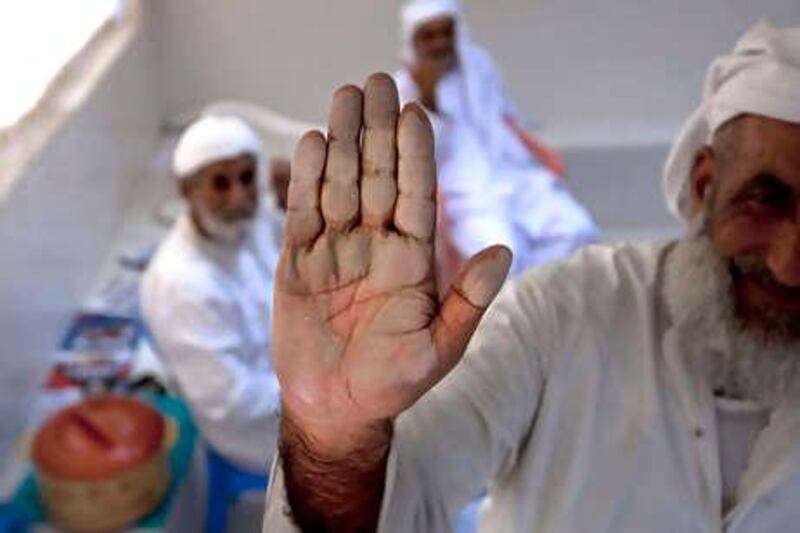GHALILAH, RAK // At the mention of goats, the majlis fell silent. Those present at the traditional gathering knew they would not like what they were about to hear. "One died today," said Abdulla Khamisu, a man of about 70 who owns some 50 goats. His fellow goatherd, Hassan Saeed, 64, had similarly distressing news.
"I had five die this month," said Mr Saeed, 64, an owner of 20 goats. "One was small, good." The men of Ghalilah, who meet every evening in a waterfront majlis, are concerned that traditional local industries are on the verge of extinction because of air pollution and water shortages. As commercialism in the form of cement factories and quarries have expanded in the last 10 years, so has the threat to their livelihoods.
Their goats are literally dropping dead. Mountain honeycombs, once found in abundance, are now a rarity. Date palms are grey with dust from lorries and factories, some just a few hundred metres away. Wells are dry, drying up or being fouled. "Before, in one month, one goat might die, but now every day goats die," said Mr Khamisu. "The ground is polluted and the goats eat the grass." Dr Alaa el Din Hassan, a veterinarian at the Al Waha Vet Clinic in Ras al Khaimah, said the pollution was a "major factor" in causing loss of life on farms.
"Primarily, their digestive system gets affected and, secondarily, their respiratory system," he said. "The pollution also causes deprivation in the animal's immunity system." Traditional industries were the life source for families who migrated to the north coast from the mountains in summer. That may not be the case much longer. Ahmed Abdul had 500 date palm trees four years ago, more than 400 of which have since died. Three of his goats died this month.
"The pollution comes and all our trees die," Mr Abdul said. "For 30 years it's been a problem. When they opened these companies the pollution was little, but year by year it increases. The water became salty and the air became dusty. Before I was selling dates in Abu Dhabi and Dubai, but now I have none." He is not the only one suffering from diminishment. Half of Mr Khamisu's 200 trees have died because of a water shortage.
"Before the dust, we didn't have to wash the dates," he said. "We had good water, the dates were clean and we didn't have illness before. Since the dust came everything is sick. The trees are sick, the people are sick, the water is dirty." In the past, 50 cars from Ghalilah were filled with dates to export. They will be lucky if they can fill two this year. The town had a revenue of about Dh180,000 from dates 10 years ago, say the farmers. The surrounding area was thick with date palm trees.
"Now there's none," said Mr Saeed, picking through a basket of fresh dates. "Before, we would eat it straight off the tree. Look at this, it's all garbage. What is this? Forty years ago we had no AC but our goats were healthy. From Ajman, Dubai, people came here in the summer because it was very nice." The men looked through photographs of Ghalilah from the 1950s, which show palm fronds houses on the beach, and more recent photos of grand pieces of honeycomb, several feet in length, which can no longer be found.
"There's been no honey for 10 years," said Mr Khamisu. Although the local honey is not as clear as it once was and its taste is not of the same quality, its price has doubled because hives are less common and smaller than before. Where honey output was once measured in litres, a beekeeper will usually get about 300 millilitres from today's honeycombs. Mohammed Salem, a respected local medicine man, will proudly tell strangers about the 11 wounds on his backside from his honey-collecting days. He is also quick to note that asthma and allergies were unknown 30 years ago. His friend Mohammed Abdulla, a renowned honey collector, believes that dust can be controlled with tighter regulation.
"The factories that put filters in them are good, but at night it's very bad and the Government knows," said Mr Abdulla. @Email:azacharias@thenational.ae





